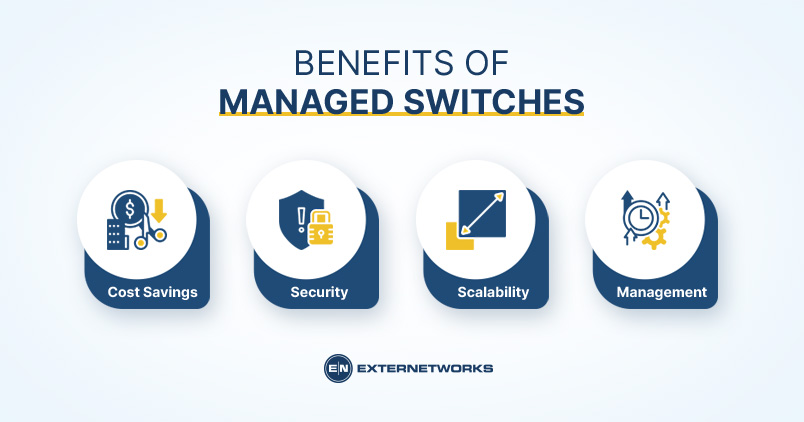28.4k views
Switching technology has changed dramatically since the first Ethernet LANs were introduced. Today’s switches are smaller, faster, and easier to install.
The best way to choose switching solutions depends on your requirements. There are three types of switches: managed, unmanaged, and wireless. Each type offers advantages and disadvantages, so it’s important to understand what you need before buying. In this article, you will see more about what is managed switch and their benefits.
A managed switch is a device that connects computers to networks, and it allows network administrators to manage the configurations of these network devices remotely. The managed network service provides security features such as intrusion prevention systems (IPS) and firewalls, which protect against unauthorized network access.
The main differences between managed and unmanaged switches are their level of control and cost. A managed switch offers more control than an unmanaged switch, allowing you to configure settings like port speed, duplex mode, VLAN tagging, etc.
In addition, it provides advanced network security features such as IDS/IPS, firewall, and VPN capabilities. This makes them ideal for small businesses. On the other hand, unmanaged switches are cheaper and easier to set up. They don’t offer any additional security features but come at a lower price.
The best way to decide which type of switch to buying is by looking at what you want to achieve from it. If you’re looking to secure your network, you should consider buying a managed switch, which will give you access to all the above features.
If you don’t require any of those features, then you might find that an unmanaged network switch is enough for your needs. In this case, you can save money by choosing one without any additional features.
A managed network switch enables complete control of data, bandwidth, and traffic control over an ethernet network.
Managed switches have many advantages over unmanaged switches, including:

There are two types of switches: Managed and Unmanaged. Both types come in different sizes, but they both perform similar functions. However, there are some differences between them.
A managed switch will give you network access to all the settings on your router. You can configure it to automatically update firmware, set up port forwarding rules, and monitor traffic. It may also detect potential threats and block them before they reach your computer. If you don’t want to pay for this extra layer of protection, then you should consider buying a separate router instead.
We recommend getting a managed switch if you’re new to networking because it’s easier to set up. And if you already own a router, you might want to save money by using your existing equipment. The best choice depends on your need and where to place your switch. If you’re looking for something basic, you should probably get an unmanaged switch. But if you want to ensure everything works properly, you’ll have to invest in a managed switch.
A managed switch service provides many different functions. It connects computers to local area networks (LAN), wide area networks (WAN), and storage area networks (SAN). It allows users to configure settings remotely. It provides firewall protection. And it offers a variety of security features, including IDS and anti-virus software.
